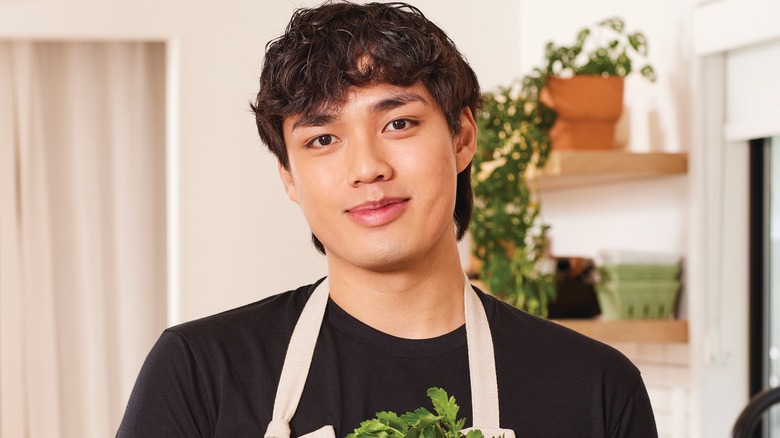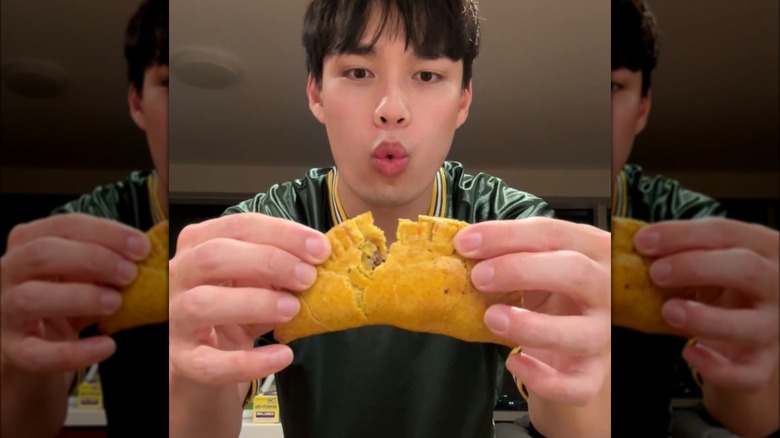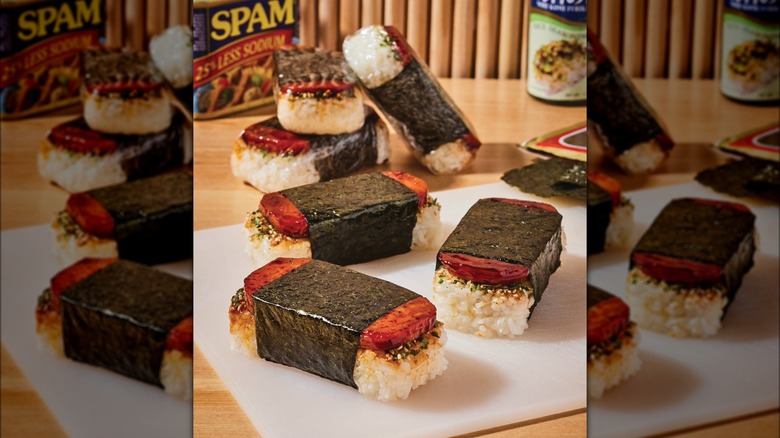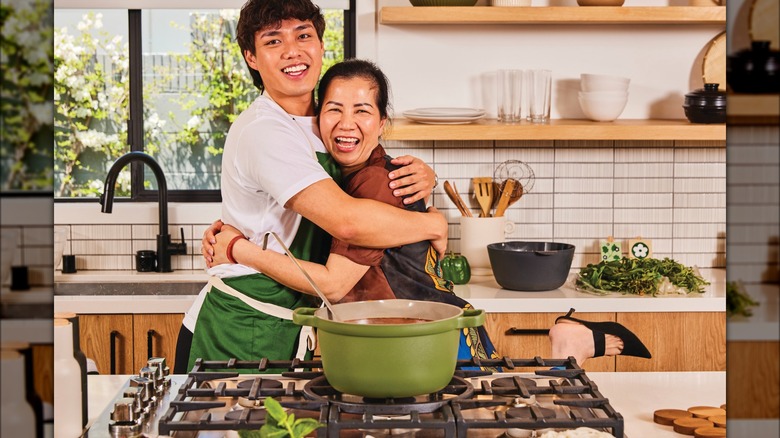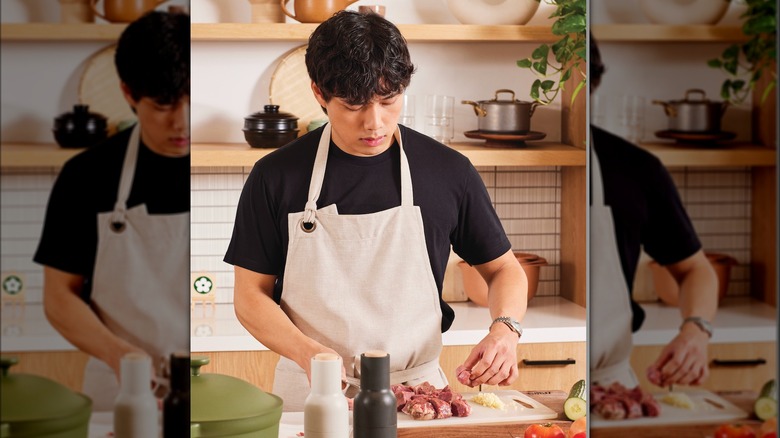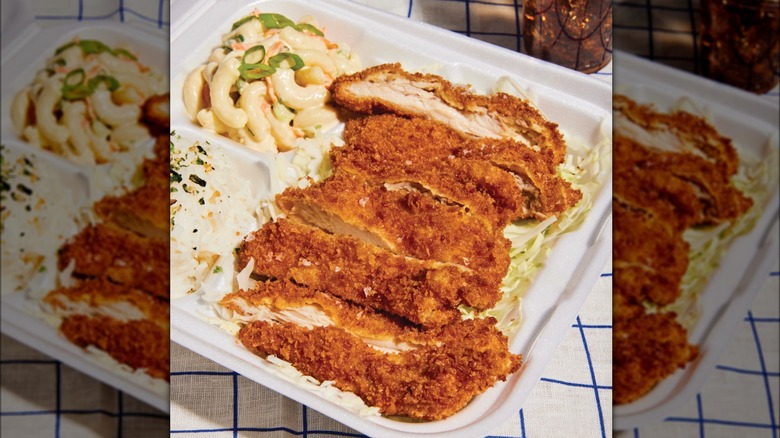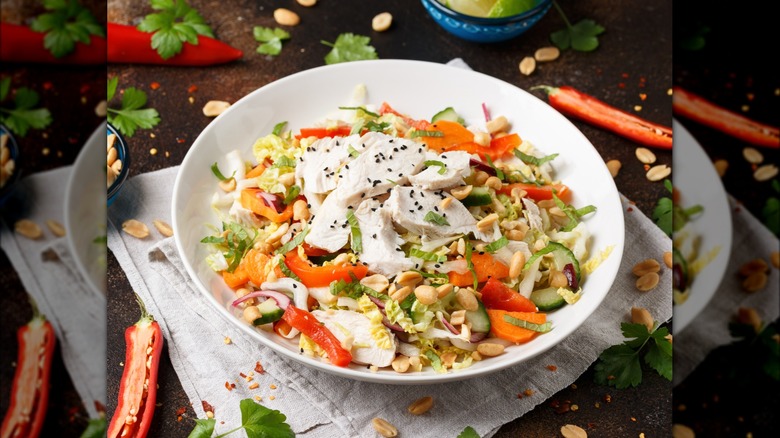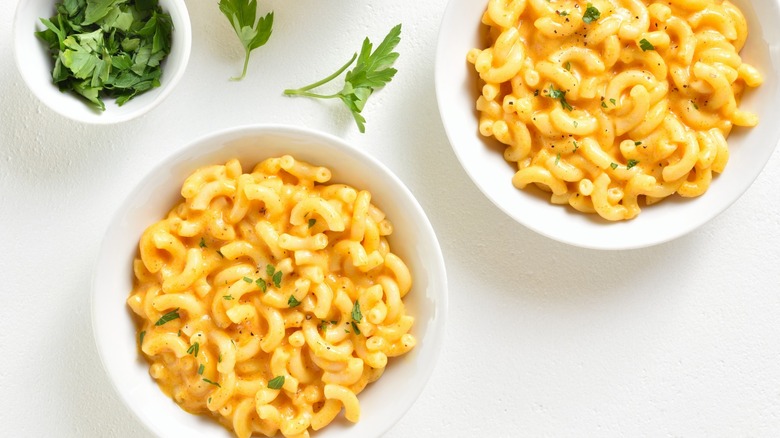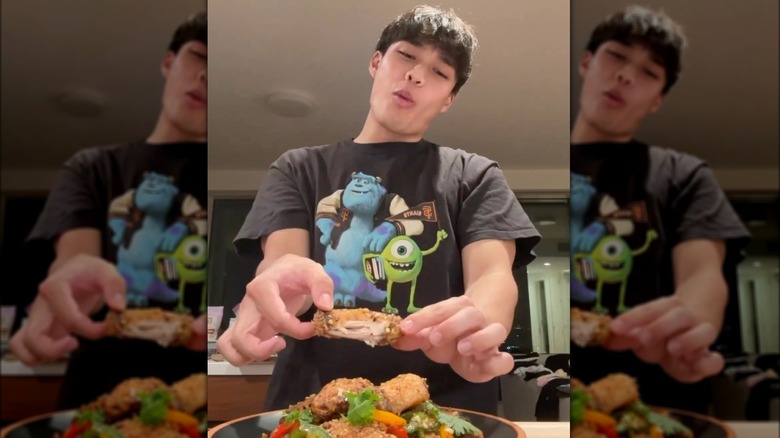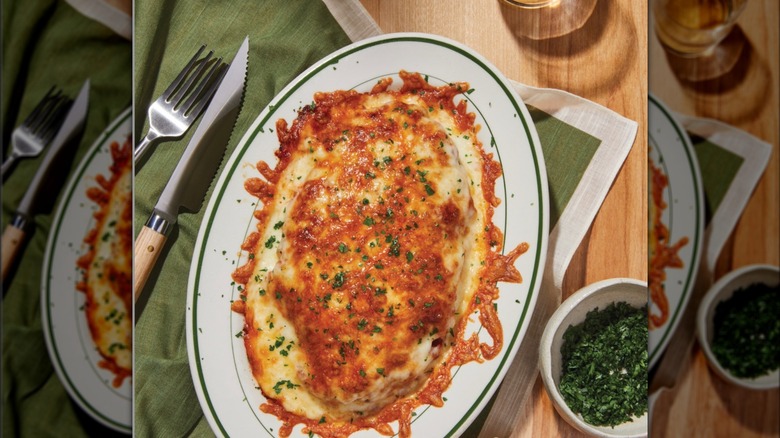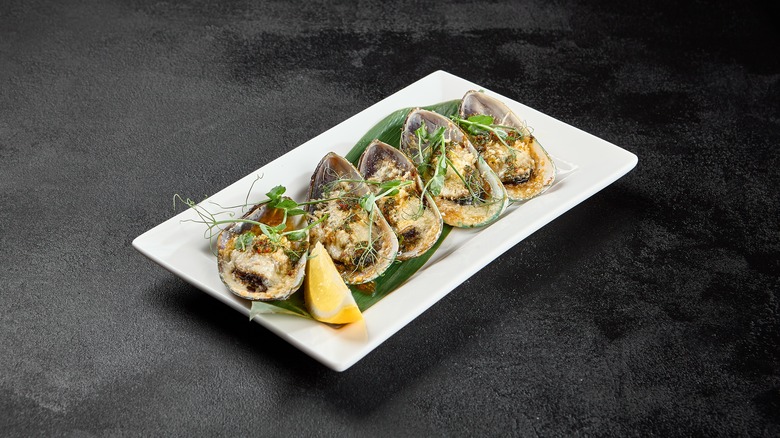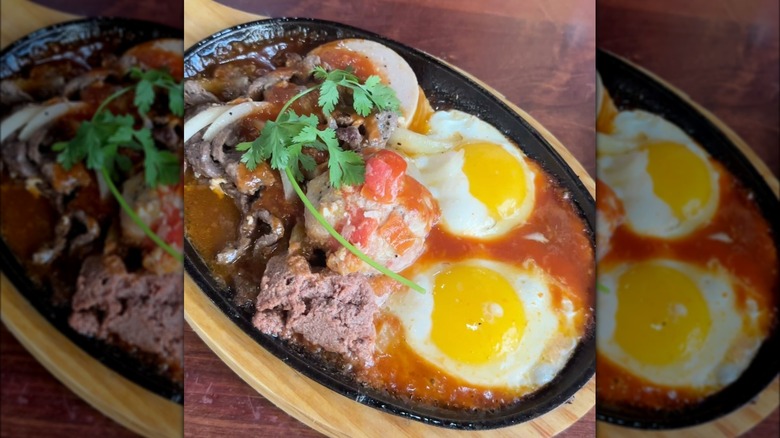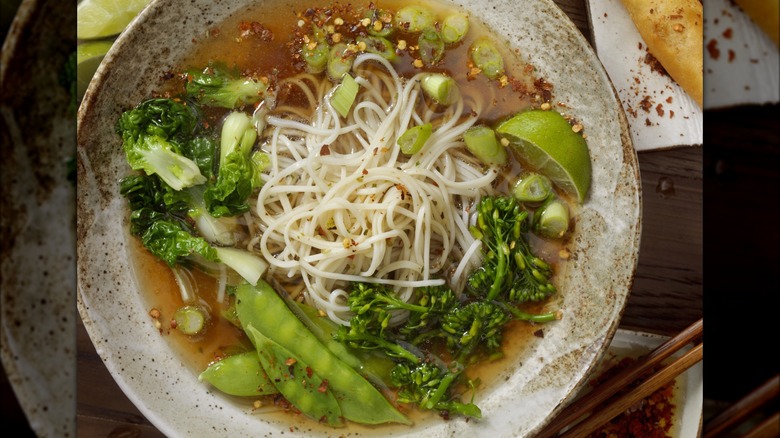Newt Nguyen On Bringing Asian Flavors To American Comfort Foods - Exclusive Interview
Twenty-something TikTok foodie Newt Nguyen didn't dream of being a cook. But with his charming personality and killer sense of style, Nguyen knows how to make cooking any dish endlessly scroll-worthy and addictive to watch. In his forthcoming book "Newt: A Cookbook For All" Nguyen curates a collection of recipes that speak to his cross-cultural upbringing: the Mexican dishes that remind him of growing up in San Jose, the Vietnamese staples his mother used to cook for him, and the Asian flavors he's since discovered within his newly-adopted hometown of Los Angeles.
Newt's cookbook is an invitation for the novice cook to go from self-proclaimed foodie and takeout aficionado to kitchen hero. With his signature brand of humor, Nguyen demystifies techniques that would otherwise feel intimidating, like executing a super-smooth hummus and making your own shrimp toast. In preparation for the launch of his cookbook, we sat down with Newt to discuss his culinary inspiration, how he works with his fans, and why Kewpie mayo belongs in everything.
The show that inspired his cooking career
In the intro to your book, you're honest about how cooking wasn't your lifelong passion -– you mention it was a bout of depression that kick-started your interest. Could you talk a little bit about the role cooking played in your life then, and the role it plays for you now?
Yeah. So, I mean, I was working at a restaurant where my mom was one of the cooks and my sister was the manager, and it just got to the point where it was two years in, and I felt stuck in life, so I just quit. And I just fell into a depression. I don't know how it happened, but it did, and cooking pretty much got me out of it because when I was depressed, I was always watching videos online. Well, not videos, but some form of entertainment.
And I really gravitated toward a show called "The Chef Show" on Netflix, featuring Jon Favreau and Roy Choi, who are two of my favorite chefs in the world. And I found that cooking was a really fun outlet for me just because it's like building Ikea furniture, you know what I mean? You go by the ingredients. You do step one, connect A with B, and then you screw the two things [together].
It was the perfect kind of storm because, at that time, my sister was working a lot of jobs, and she found herself struggling with her weight because she was eating a lot of fast food because she didn't have time, working two, three jobs. And I just took the opportunity to cook for her, meal prep for her, and that's how I fell in love with cooking.
On crowdsourcing inspiration from his fans
And now, obviously, you've built this career off of cooking. Have you fallen in love with cooking now?
Yeah. For the recipes in the book, it was a lot of cooking the same recipes over and over, but cooking has always been one of my biggest passions. I guess it's more so the cultural aspect of it because I have this thing where I take recipe suggestions from people who comment on my videos. Just a few weeks ago, people were commenting about samosas, and they were commenting about soul food, collard greens, fried chicken, and so on. And these are things that I haven't really had any experience cooking. And I find a lot of joy, personally, in researching recipes, learning more about the cultural aspect behind the cooking, and I love trying new recipes.
What do you think it is about you personally that gets people so excited to watch you cook?
I don't know. I would say I got pretty lucky during quarantine because I started doing my cooking videos right before quarantine hit, and during quarantine, as we both know, everyone was forced to stay inside and they didn't really have a choice but to consume content. But when that was happening, I knew a lot of people were struggling — they were staying at home and they were getting depressed, and I just got back to a point in my life where I wanted to be the Jon Favreau or Roy Choi to them. So that's when I launched my cooking videos with a more funny type of commentary behind them. Nowadays, I don't do too much of that. A lot of my cooking videos are just me cooking with music in the background, but I would say it's 50/50.
Why he sold spam musubis with his mom
You didn't grow up with a lot of money –- you mention that you sold Spam musubis [in school] for a little bit of extra cash. How has your upbringing influenced your relationship to food and cooking?
My mom has the biggest influence on me because she grew up a cook. When she first came to America, she was a cook under my godmother, and my godmother is a chef, and she was the chef at the restaurant that we worked at. And throughout my mom's life, she's been hopping around to different Vietnamese restaurants, so she's very well-versed in Vietnamese cuisine.
But no, that Spam story, I think I would say that was my real introduction in the kitchen, making Spam musubis. That was a very important time in my high school life. Like you said, I grew up with very little money. My parents combined probably made, I don't know, less than $50,000. We lived in a mobile home. We still live there, or they still live there. And I was walking around and I saw a lot of my friends buy new shoes and new clothes. And when you're in that situation, you don't want to ask your parents for money. You know what I mean? They provide a roof over your head and they give you all the love that they can, and I just wanted to make a thing of my own, and that's when we started selling Spam musubi.
And it was pretty interesting because I don't think it was legal to sell Spam musubi in high school. You're not supposed to sell goods that you make at home, but we did it anyway, and we were running away from the advisors, and I had people who were selling for me. It was kind of like a drug operation, but without drugs. It was just food. So that allowed me to save up a lot of money and buy the things that I wanted in high school.
What were the exact logistics of the operation?
I would go home and my mom would buy the canned Spam from Costco. And it's funny because, during the times when they would have sales on Spam at Costco, you were only limited to two cans or two blocks, and she would buy it, go out, come back in, buy it, go out, and she would repeat that process. And one day, I would come home and she would have maybe 100 cans. Yeah, she's a sweetheart. And I would go home and we would just start the prep right after school. So I would cut the Spam, fry it with her, she would make the rice, season the rice, and then after one or two hours, we would be sitting together, sitting across from each other at our kitchen table and just folding musubis for an hour every day. And then the next day, I would offload it to two of my friends, they would sell it for $2 apiece, and I would give them a little bit of money, and then I would just collect the bags at the end of the day and go home and repeat.
Learning how to cook Vietnamese from his mother
You mentioned your mom is a talented Vietnamese cook. Do you guys cook together?
I would say we haven't really cooked together. The only time we've really cooked together was when she was at my apartment while I was working on this book. And my sister actually has a photo of both of us in the kitchen, which is very rare. When too many people are trying to cook something, it's very irritable in there, and we don't want to butt heads.
When I saw the photo that my sister took, it really touched my heart because it was a picture of her and me facing the stove, and it was almost like ... I don't know if you've seen the Ninja Turtle picture where it's all the Ninja Turtles and they're walking off into the sunset with their master. He's a shorter type of rat guy. So it reminded me of that; she's a really good cook, and now she's teaching me how to cook Vietnamese cuisine. It was very, very lovely.
Like your sensei.
Yeah, she is my sensei, for sure.
How he learned culinary technique
That's very cool. Well, speaking of technical skill, it seems like you're self-taught. Although you've worked in restaurants, you didn't go to culinary school yet you have unmistakable technical skill. I was watching you dice vegetables for a bolognese sauce, and I was like, "Wow, he really knows what he's doing."
A lot of the skills that I have are just from watching people. I do want to take classes eventually because I feel like there's a lot of things that they teach you in school that you can't get maybe from videos, but I do follow a lot of people who are even way better than me at cooking. One of my favorite cooking accounts is Made by Musashi, which is a boyfriend and girlfriend duo. The girlfriend is the videographer, and she does the editing and stuff, and he's the cook, and he works in fine dining in New York. So I follow a lot of these actual chefs, and I just look at what they do and, "Oh, they hold their knife like this. Maybe I should do this. Oh, they use this cutting board. Maybe I'll buy the cutting board." So yeah, it's a lot of just watching other people and imitating.
What makes the best fried chicken
Okay, let's talk a little bit more about your food. You have a whole section in your book dedicated to fried chicken. And then you also mentioned, in your chicken adobo recipe, that Jollibee has the best fried chicken in the world. What makes it so special to you?
Oh, I don't know. Okay, Jollibee's fried chicken, the outside is just perfectly golden and crispy and the chicken has always been juicy. I've never once went to Jollibee and felt like the chicken was overcooked or dry. When you go to KFC and Popeye's, sometimes they're in a rush or it's been sitting out and it's not fresh, but Jollibee, to me, it's always fresh. And they do this thing where they inject a spicy seasoning inside the spicy fried chicken that gives it so much flavor that ... I just love it so much.
Into the chicken itself, you think, or in the batter?
I think into the chicken itself because, when you peel apart the breading, you see an injection mark and it's red.
The nostalgic Vietnamese dish that's important to him
You refer to this cookbook as a "coming-of-age cookbook," and a lot of the recipes that you have in it seem like the recipes that you enjoyed when you were a child. What are some of your favorite recipes or maybe some of the most nostalgic recipes in the book?
Well, my favorite and the most nostalgic recipe, it's a Vietnamese chicken salad, which really isn't even a salad because it's just poached chicken, Vietnamese coriander, and onions, seasoned very simply with salt, fish sauce, and lemon juice, which is, when you think of a salad, you think of, "Oh, where's the Caesar? Where's all the other lettuce?" and stuff like that, but it's pretty much just all meat.
And the reason why that's so important to me is because my mom used to make it ever since I was a kid, and I remember the first time I had it, I just loved it so much. And growing up, every time she made it ... I'm not sure if you're familiar with Vietnamese coriander, but you have to pick the leaves. They're super fragrant. You have to pick the leaves. And just imagine my mom cooking in the kitchen, and I'm on the floor, there's newspaper on the floor, and I'm picking the leaves for her so that she can make my favorite food. So that's my favorite recipe, for sure, and the most nostalgic, too.
On incorporating Asian flavors into American comfort foods
You have a mac and cheese recipe in your book, and interestingly, it calls for both Gouda and Kewpie mayo. What inspired you to use both of these ingredients in it?
I don't know. I think, one time, I made mac and cheese, I think it was during Thanksgiving or something, and then I saw a recipe call for mayonnaise. I'm not sure, I haven't made that recipe in a while. So when I was working on this book, I was just thinking about how I could incorporate more Asian flavors, and Kewpie mayo is a mayo that I really love. It's a Japanese mayo. So I just went with that. There was no crazy reasoning behind it in terms of taste.
Are there any other recipes that you like to use Kewpie for?
Off the top of my head, I don't remember. I think I might've used it for the bang bang shrimp, as well, but yeah, I can't remember off the top of my head.
What do you like about it?
I don't know. It has a more eggy type of flavor that I like.
Yeah. I wonder what's in it.
Yeah. I could search it up right now. Let's see. I also like the bottle. It's a very squishy bottle.
Yeah, totally. It just has this cult following.
Maybe there's some MSG in it. It has a "richer, velvety flavor than a regular store-bought mayo," people said. Okay, cool. Yeah, more eggs.
On using two fats in his chicken wings recipe
You have a butter wing recipe. Is it worth using both the fats, and what is your justification for people who are thinking, "Ah, that's so much fat?"
Okay. That is probably the unhealthiest recipe I have in my entire book. It's horrible, but it's really good. So that recipe actually came from my godmother. It was from the restaurant that we worked at. It was called 1150, and the butter wings were one of the best-sellers. And as a server, I would always have to explain to people. They're like, "Oh, what are butter wings? You toss them in butter after you fry them?" I'm like, "Yeah." And I would have to explain to them, "No, no. Trust me, it's really bad for your cholesterol, but it's really worth it." I put that recipe in my book more because it's super nostalgic. It reminds me of the times when I was going to school afterward, or after college, I would go to the restaurant to do homework, and then I would eat the butter wings. And until this day, I think it's one of the most unique kinds of wings I've ever had.
How did they make them in the restaurant, and then how does your recipe differ, or do you feel like you tried to adapt it pretty consistently from theirs?
It's actually one-to-one. My mom worked in the restaurant, so she pretty much told me what was in it. And yeah, it's pretty much just like you fry the wings and then you toss them in butter, bell peppers, MSG, as a lot of Asian restaurants use, and a bunch of garlic, a very unhealthy amount of garlic, but who doesn't love garlic?
Where to find the best-looking chicken parm
Your chicken parm recipe, you mentioned, is a riff on Rizzo's House of Parm, Matty Matheson's restaurant. What makes his version so special? And also, has he influenced your approach to cooking?
I just found out about Matty Matheson recently. Let me pull up a picture of ... Let's see, chicken parm. Yeah, I just found out about his restaurant recently, but I think I was scrolling through Instagram, and I saw Rizzo's House of Parm, and I thought it was so different. It looks like a pizza, almost. It's in that oval kind of plate. It's a gigantic piece of chicken cutlet and there's so much cheese. He threw on an insane amount of cheese, and he melted it, and it looked so yummy. So when I was coming up with what I wanted my chicken parm to look like, his came to mind because that's the best-looking chicken parm ever. I have yet to try his, though. I want to try his restaurant.
The unlikely preparation he prefers for mussels
There's a recipe in your book for grilled mussels, and most people think of steaming when they think of mussels, which is more of a French application. Why did you decide to grill yours, and where did you get the inspiration for that dish?
Grilled mussels are actually a Vietnamese bar food. So if you go to Vietnam, you can find this at a lot of open street vendors. So that's where I got the inspiration. But that's also one of my favorite dishes, too, because as a foodie, I'm really big on texture. And that one, the mussel texture is okay, it's a little rubbery, because a lot of street food, in Vietnam at least, is overcooked. So there's that rubbery aspect, but then I also top it off with fried shallots and a whole bunch of other things. And it also has butter, so it's not as healthy, as well. But yeah, it's definitely one of my favorite dishes, for sure.
All about bò né
Can you talk a little bit about your Vietnamese steak and eggs recipe?
Is that the bò né? Yeah, bò né is just a Vietnamese breakfast type of dish. So it's a cubed steak, and you just cook it, or it doesn't have to be cubed, but I like eating it cubed. Sometimes it's just cooked as a filet. And it has eggs, it has cherry tomatoes, it has pork pate, which I don't think I added in the cookbook, just because not everyone eats pate. It's controversial. But yeah, it's a classic Vietnamese dish.
That sounds so good. Did you grow up eating it?
No. It's not a thing where you cook at home because it's kind of hard. It's more so you would go to restaurants and stuff. Yeah, I grew up going to a lot of restaurants in San Jose eating it. And the last time I went to Vietnam, I think it was over 10 years ago, we went to a really good restaurant for it.
His favorite Vietnamese restaurant in Los Angeles
You just moved to Los Angeles, but what are the best Vietnamese restaurants in the city that you've found so far?
Okay. I've tried a lot and I don't like a lot of them. I don't know if it's because I'm from San Jose where I'm spoiled, because San Jose has one of the biggest Vietnamese populations, but one that I really like that's in the Arcadia area is called Nha Trang Restaurant. It's the most authentic. They have the best spicy beef noodle soup. And pho, too.
What makes the spicy beef noodle soup so good?
You know what? When you go to different restaurants, sometimes the flavor, they don't simmer the bone broth enough or they don't use enough lemongrass. And this restaurant, they don't skimp on the lemongrass. It's very aromatic and it's very flavorful.
If you could pick three ingredients that characterize Vietnamese cooking for you, what would they be?
Oh, lemongrass, for sure. I don't know. I would say lemongrass, garlic, and onions, or if you want a taste that's very prevalent in Vietnamese cooking, we have this thing called nuoc mau, which is Vietnamese caramel. You cook down sugar until it turns into a caramel. A lot of our, what would you call it, braises start off with that.
"Newt: A Cookbook For All" is now available for purchase here. Keep up with all things Newt Nguyen on Instagram and TikTok.
